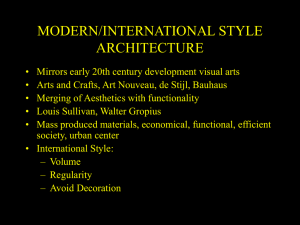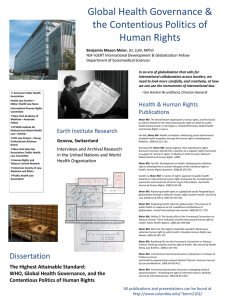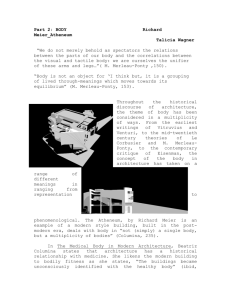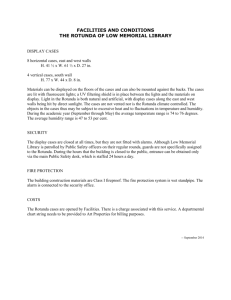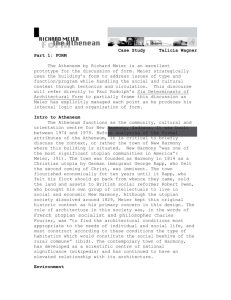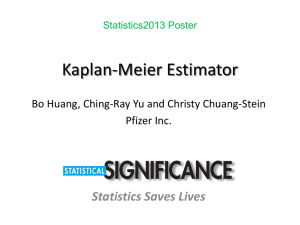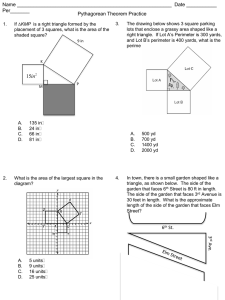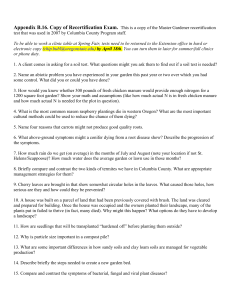Richard Meier - creativemindsnitc
advertisement
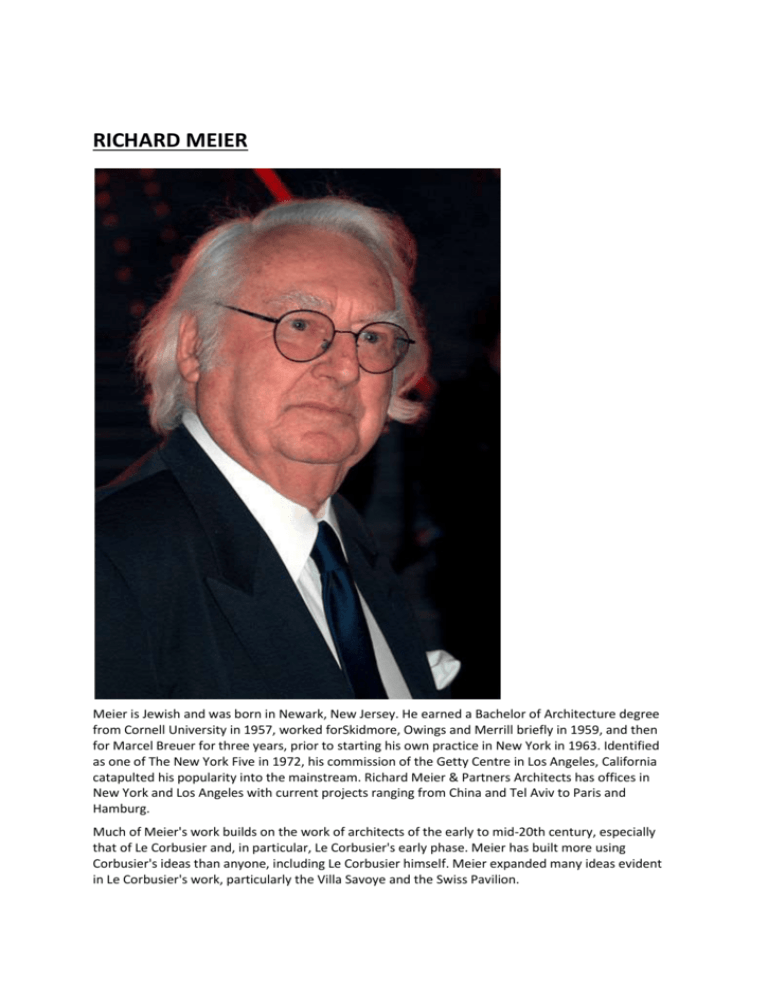
RICHARD MEIER Meier is Jewish and was born in Newark, New Jersey. He earned a Bachelor of Architecture degree from Cornell University in 1957, worked forSkidmore, Owings and Merrill briefly in 1959, and then for Marcel Breuer for three years, prior to starting his own practice in New York in 1963. Identified as one of The New York Five in 1972, his commission of the Getty Centre in Los Angeles, California catapulted his popularity into the mainstream. Richard Meier & Partners Architects has offices in New York and Los Angeles with current projects ranging from China and Tel Aviv to Paris and Hamburg. Much of Meier's work builds on the work of architects of the early to mid-20th century, especially that of Le Corbusier and, in particular, Le Corbusier's early phase. Meier has built more using Corbusier's ideas than anyone, including Le Corbusier himself. Meier expanded many ideas evident in Le Corbusier's work, particularly the Villa Savoye and the Swiss Pavilion. JUBILEE CHURCH,ROME For the new millenium, the Vatican decided to found 50 new churches in Rome. In 1995 an international competition for the church in tor tre teste took place, which was won by Richard Meier. So in 1998 the work started, it took five years until the competition of the church. The church is situated in a suburb east of Rome, surrounded by 1970's apartment blocks and on the edge of a huge park. Light is the main theme inside the Church. Three shells for the inside of the nave, the roof and the slots between the shells are made in glass. The large amount of glass and the materials give you the feeling of being outside under the light sky. The south side of the church features three large curved walls of pre-cast concrete. (The walls form segments of spheres.) Meier claims to have designed the church to minimize thermal peak loads inside. The large thermal mass of the concrete walls control internal heat gain; the result is less temperature variation, and supposedly more efficient use of energy. The walls also contain titanium dioxide to keep the appearance of the church white. Three circles of equal radius generate the profiles of the three shells that, together with the spine-wall, make up the body of the church nave – and discretely imply the Holy Trinity. Transparency and light cascade down from the skylit roof, literally invading the interior of the church also penetrating from below through a narrow slot opened at floor level. People in the atrium are enveloped with mystical light With the structure supported by the curved cantilever of the concrete-clad shells, reaching over towards the opposite "spine" wall, the west (altar) and east (organ) walls are light glazing, surrounding the bright, white set pieces for the cross. Taking part in a prayer, you feel like celebrating in the presence of God because of the roof of the nave, the eastern and the western facade entirely made in glass. Despite all the glazing, the geometry is such that direct sun almost never comes into the church. Getty Center Meier has exploited the two naturally-occurring ridges (which diverge at a 22.5 degree angle) by overlaying two grids along these axes. These grids serve to define the space of the campus while dividing the import of the buildings on it. Along one axis lie the galleries and along the other axis lie the administrative buildings. Meier emphasized the two competing grids by constructing strong view lines through the campus. The main north-south axis starts with the helipad, then includes a narrow walkway between the auditorium and north buildings, continues past the elevator kiosk to the tram station, through the rotunda, past the walls and support columns of the exhibitions pavilion, and finally the ramp besides the west pavilion and the central garden. Its corresponding east-west visual axis starts with the edge of the scholar's wing of the Getty Research Institute (GRI), the walkway between the central garden and the GRI, the overlook to the azalea pool in the central garden, the walkway between the central garden and the west pavilion, and finally the north wall of the west pavilion and the courtyard between the south and east pavilions. The main axes of the museum grid that is offset by 22.5 degrees begins with the arrival plaza, carries through the edge of the stairs up to the main entrance, aligns with the columns supporting the rotunda as well as the center point of the rotunda, aligns with travertine benches in the courtyard between the pavilions, includes a narrow walkway between the west and south pavilions, a staircase down to the catus garden and ends in the garden. The corresponding cross axis starts with the center point of the circle forming the GRI library garden, then passing to the center of the entrance rotunda, and aligning with the south wall of the rotunda building. Although all of the museum is aligned on these alternative axes, portions of the exhibitions pavilion and the east pavilion are aligned on the true north-south axis as a reminder that both grids are present in the campus.
